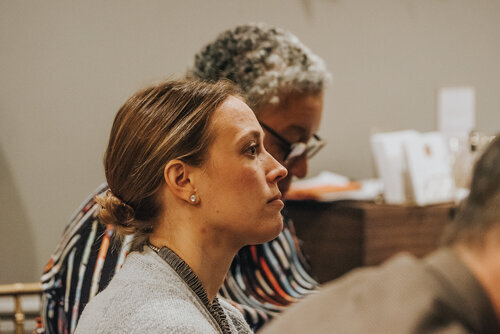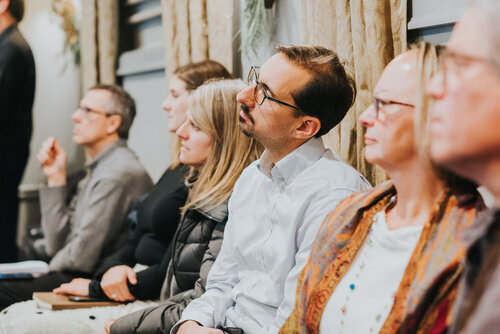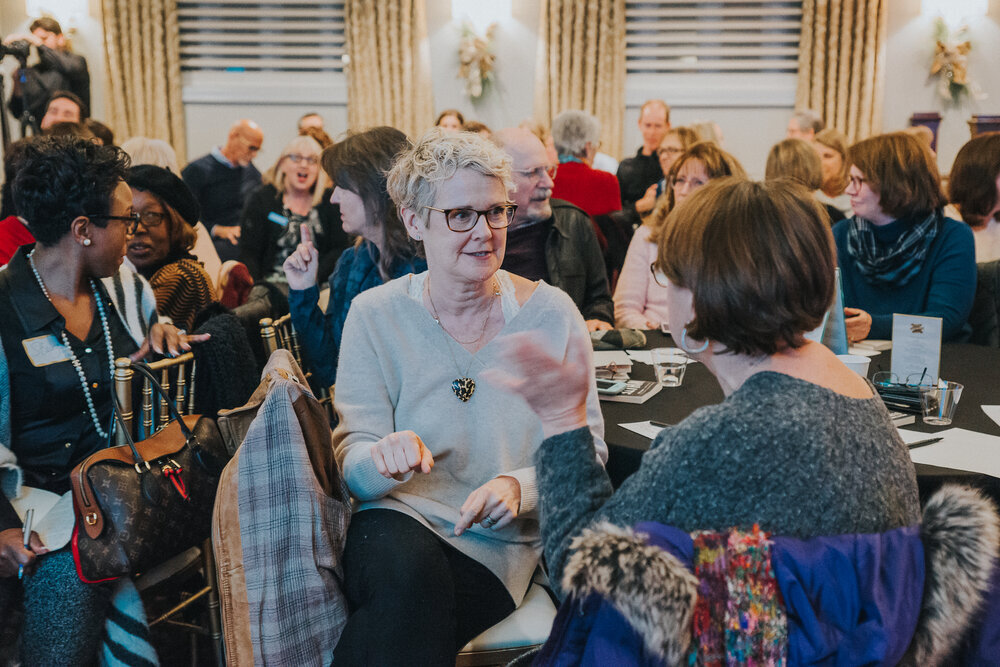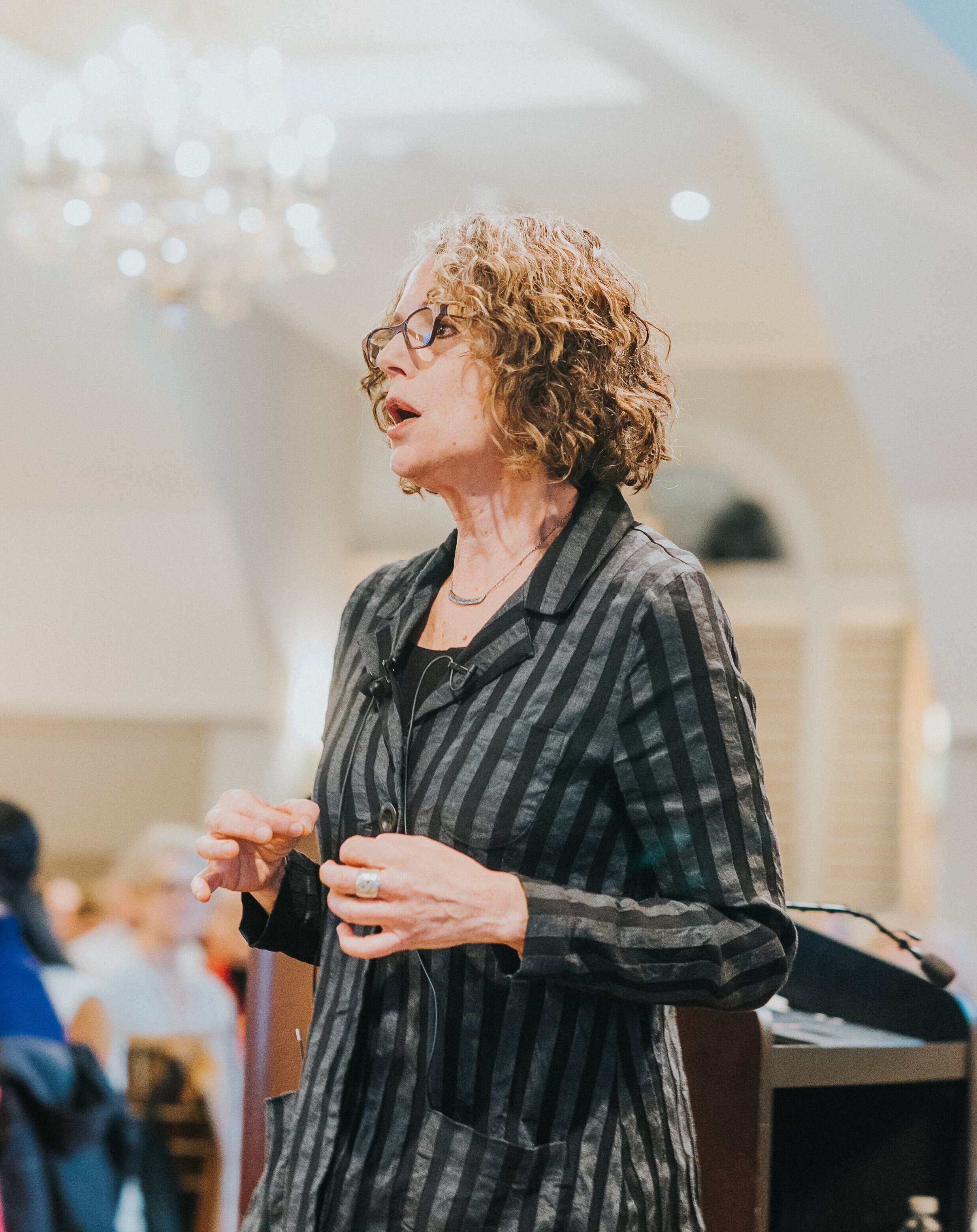BY TAMARA TABEL
“I’m going to talk about arguably the most sensitive, charged, complex, nuanced, social dilemma of the last several hundred years.”
-Dr. Robin DiAngelo
On January 8, A Year of Courageous Conversations welcomed New York Times bestselling author Dr. Robin DiAngelo to Barrington’s White House, where she challenged the white guests in a diverse audience to think differently about how race shapes our lives. The event was over-sold with a long waitlist from across the Chicagoland area.
Robin DiAngelo, Ph.D. is an academic, educator and author in the fields of critical discourse analysis and whiteness studies. In a 2011 academic article, she coined the term “white fragility” which has influenced the national dialogue on race. She later expanded her work into a bestselling book, White Fragility: Why It’s So Hard for White People to Talk About Racism.
For over twenty years, DiAngelo has been a consultant and trainer on issues of racial equity and social justice. Her numerous publications and books also include the books Is Everyone Really Equal? and What Does It Mean to Be White? She serves as affiliate faculty at the University of Washington, and traveled from Seattle for this talk in Barrington.
Understanding Ourselves
“When we come together for professional development, a class or a seminar on race and racism, we tend to study the racial ‘other’,” said DiAngelo. “Whiteness is typically left off the table.”
White people first need to understand ourselves and our biases before we can help strive toward racial equity.
Drawing attention to her own whiteness, DiAngelo explained that we do not often see white as a race, but that it affects how we see and move through the world. “We see things from a white frame of reference, a white point of view,” said DiAngelo. “As we move through the environment, our white experience is deeply separate and unequal from the black experience.”
Everyone has biases, DiAngelo explained. White people cannot help but be racially biased because of the white experience we live. We need to become more self-aware, to admit our unconscious biases, and to overcome our initial resistance.
“I don’t want you to understand me better, I want you to understand yourselves. Your survival has never depended on your knowledge of white culture. In fact, it’s required your ignorance.”
Why It’s Hard to Talk About Race
Discussing race and racism is often difficult, especially for white people.
We struggle with humility. Just because we have opinions doesn’t make us informed.
We often use our reactions as a way out, to not venture into seeing and addressing our biases because it’s uncomfortable. “The key will be what you do with those moments of discomfort, to use as a way in,” says DiAngelo. “Why is this so unsettling? Why does this feel threatening? Why am I beginning to feel angry? What would it mean if I would just try this on?”
We see ourselves as unique individuals, unaffected by the culture we live in. We aren’t used to being seen racially. “Everything you see as different about you, ask yourself: How did that set me up into the racial hierarchy I live in? Nothing exempted you from the water we’re swimming in. It’s up to you to figure out how it set you up, not if.”
Language Matters
DiAngelo led a breakout exercise to define terms we may use interchangeably, but have different meanings:
Prejudice is a prejudgment about social others as defined in a given culture.
Discrimination is external. When we act on prejudice, we now discriminate.
Systemic Racism takes place when we back a group’s collective bias by legal authority and institutional control. It gets embedded in every institution and our cultural definitions.
The common definition of a racist is an individual who consciously does not like people based on race and is intentionally mean to them. This implies intent — that you are a “bad” person if you hold a racist view, regardless of whether it is subconscious.
DiAngelo posits that this definition is the root of virtually all white defensiveness on this topic and serves to protect the system of racism. “If this is my definition of racism and you say something I’ve said or done is racist,” said DiAngelo, “what I’m going to hear is that you’re questioning my moral character. And now I’m going to need to defend it.”
She encouraged us to examine if this is the trigger for our own defensiveness.
“Racism is a system, not an event.”
-J. Kehaulani Kauanui
DiAngelo reviewed the history of systematic racism, beginning with slavery, mandatory segregation and lynchings, and continuing into present-day employment and educational discrimination, mass incarceration, biased media, voter suppression, and unaddressed trauma.
“Racism is a deeply embedded system. None of us could be exempt from the forces of this system. It is up to us to determine how it shaped us, not if.”
“To be white is to belong — to have opportunity, advantage and networking,” DiAngelo noted while showing photos of predominantly white social groups from politics and media. “All peoples who are not perceived or defined as “white” experience racism in this country, in both shared ways and in unique, specific ways.”
DiAngelo believes there is something profoundly anti-black in this culture. “In the white mind, black people are the ultimate racial ‘other.’ As a group, African-Americans garner the strongest response and the most energy. And where you are on the black/white continuum will affect your experience — the darker you are, the more discrimination you will experience.”
Racism in Unavoidable
Using herself again as an example, DiAngelo explained how whites cannot help but absorb racist views and behaviors because of our insular white upbringing.
“As a result of being raised as a white person in this society, I do have a racist world view. There’s just no way I could not have absorbed it. I have racist biases. As a result, I have racist behaviors. I also have an investment in the system of racism. It’s comfortable. It has worked.”
White people do suffer and face barriers, she explained, but we do not face racism. And that shapes how we manage the obstacles we do face. It’s not about feeling guilty, but about looking at how it affects your relationships, especially with people of color.
How Has Race Shaped Your Life?
DiAngelo led the audience in two reflection exercises.
First she asked participants to answer the question, “How has race shaped your life?” thinking back to our childhoods and exploring our early socialization.
In her research, DiAngelo has identified similarities in experiences and patterns in the narratives over time:
In most cases, our neighborhood, schools, friendship circles and work environments have been almost exclusively white.
Whites often “credential” by giving evidence that they are not racist.
This credentialing often cites proximity to people of color, but not true interaction.
Because these narratives point to how superficial most whites are on the topic of racism, DiAngelo encouraged us to use questions as tools. “You will not always get it right. Keep going and keep growing through those mistakes rather than shut down.”
She also warned that the inability to think critically and truly answer this question creates issues for people of color:
It creates a hostile environment for people of color living and working in white space.
Without critical thinking, we can’t effectively navigate a conversation on race.
We will have neither the skills, nor the emotional capacity to withstand the discomfort of that conversation.
The result? People of color will not be able to be their authentic selves and will instead spend time being careful not to unsettle us about race.
It contributes to an environment that is not supportive to people of color.
DiAngelo explained that there are “hidden pillars” under the surface holding up our racial biases. These include implicit bias, individualism, universalism, internalized superiority and what she calls the “good/bad binary”—meaning if I’m a good person I can’t possibly be a racist.
White Fragility
If we’re challenged on our racial assumptions, advantages or behaviors, whites often become defensive or hurt. We might deny. Argue. Insist it must be a misunderstanding. Or even withdraw or cry. This inability to tolerate the racial stress of a challenge to our positions or perceptions is what DiAngelo has termed “White Fragility.”
“When I coined this phrase,” said DiAngelo, the ‘fragility’ part is meant to capture how little it takes. But, the impact of that meltdown isn’t fragile at all. It becomes a kind of weaponized defensiveness … because it marshals behind it the weight of historical and legal power and control.”
White Fragility functions to block the challenge and regain white racial equilibrium. It works effectively to police people of color into not challenging us.
“I think white fragility functions as a kind of everyday white racial bullying,” said DiAngelo. “We make it so miserable for people of color to talk to us about our inevitable and often unaware patterns, that most of the time they don’t.”
This creates a dichotomy for well-intended white progressives. We fear accidentally saying or doing something racist, yet bristle when our mistakes are pointed out.
The Disturbing Truth
Dr. DiAngelo asked us to think about the photo albums from our weddings, our birthday parties and graduations, our future funerals. How diverse are those photos? Who is missing?
“I could go from cradle to grave with few, if any, authentic sustained cross-racial relationships, with black people in particular, and no one suggesting I’d lost anything of value.”
In fact, white people measure the value of our spaces, our schools, our neighborhoods, by the absence of black people. We view enforced legal segregation in the Jim Crow South as a tragedy, yet the chosen segregation that has come after that as okay. And the higher-class our lives are, the more likely we will be segregated.
“Racism hurts and kills people every day. So interrupting it is more important than my ego, feelings or self-image.”
-Dr. Robin DiAngelo
What Do I Do Now?
The journey begins within. We must first recognize our biases, then work to address them. It will not be easy. We have an inclination to object and dismiss our biases, partly because we have never or rarely been challenged before and it is uncomfortable. We may not be fully truthful with ourselves.
“We need to unpack that it’s not about if I’m nice or good or bad,” said DiAngelo. “We need to understand all the unconscious bias we bring to the table — the table where decisions are being made for people who are not at that table.”
Ask yourself: What has enabled you NOT to know what to do about racism? The information is all around you. Google it. Read books and articles by people of color. Your learning is not finished, and it’s on you to continually educate yourself.
Reach out, but don’t overburden your black friends with teaching you. If you have someone on your equality committee at work, compensate them extra for that incredible emotional favor.
Practice humility. Given your socialization, it is more likely that you are the one who doesn’t understand.
It is not enough to be nice. Niceness in not anti-racism. Niceness is not courageous. Niceness is not going to get racism on the table when people want to keep it off. It is not interrupting anything. Anti-racism takes courage and intentional action.
The video for this session is private for registrants. To request link & password, click below.
* * *
Seeing the Racial Water is the fifth of ten monthly sessions for A Year of Courageous Conversations exploring how to foster greater inclusion & belonging in our community. Presented by Urban Consulate at Barrington’s White House in partnership with community advisors, the series is made possible thanks to support from Jessica & Dominic Green, Kim Duchossois, Sue & Rich Padula, Barrington Area Community Foundation and BMO Wealth Management.
